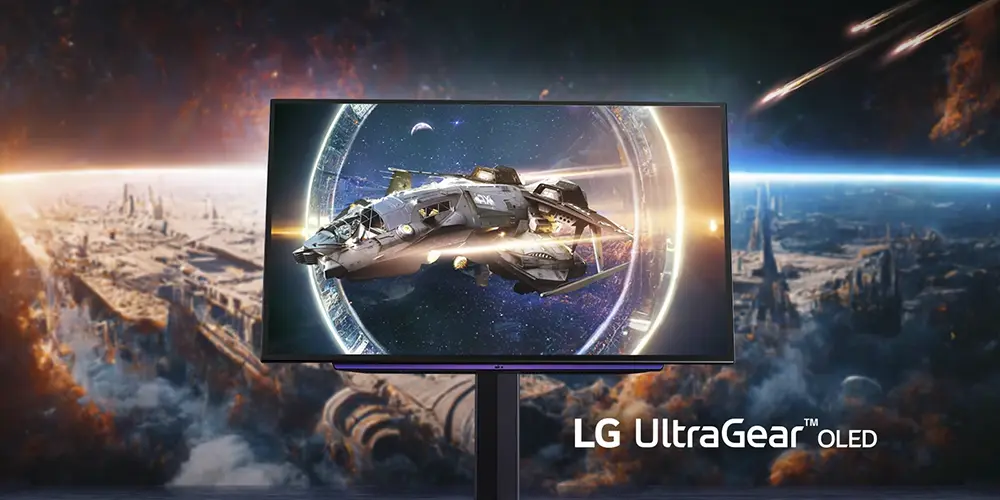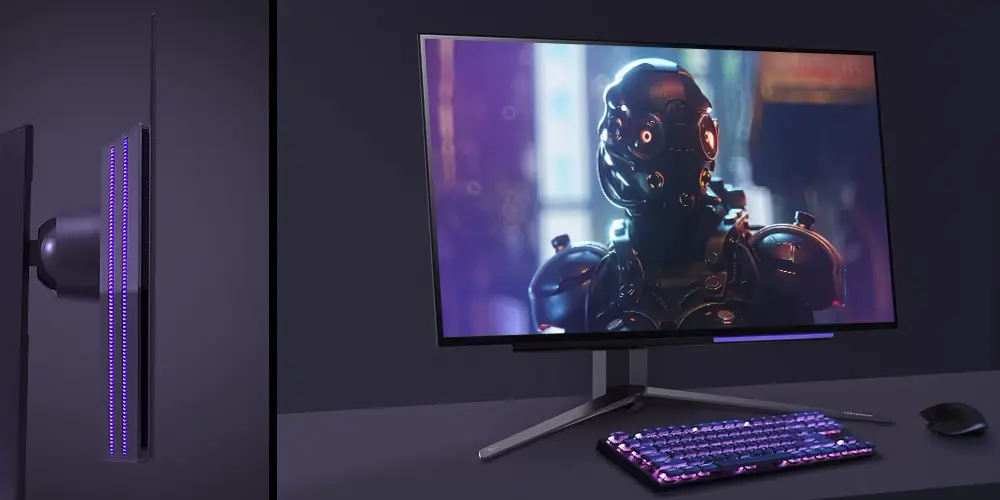Pros
- Picture quality
- Native frequency of 240 Hz
- Infinite contrast
- FreeSync and G-Sync compatibility
- Unrivalled responsiveness
- Remote control
Cons
- Maximum brightness limited in SDR
- Settings impossible without remote control
- High power consumption

The LG UltraGear 27GR95QE is one of the few monitors to feature a 240Hz OLED panel manufactured by LG Display. This differentiates from conventional LCD monitors, even the most powerful ones.
Overview
The LG UltraGear 27GR95QE is a monitor for gamers that features Oled technology and a native refresh rate of 240 Hz. This 27-inch OLED panel supports a WQHD definition of 2560 x 1440 pixels with an ultra-fast response time of 0.03 ms, enabling it to display smooth, accurate images. Moreover, FreeSync/AdaptiveSync technology and G-Sync compatibility between 48 and 240 Hz with LFC support guarantee a gaming experience without image tearing or micro-skips.
The LG UltraGear 27GR95QE is the first model to be equipped with a 240Hz OLED panel manufactured by LG Display, but it is still expensive. It retails for around £1,000. The Philips Evnia 34M2C8600 with its 175 Hz QD-OLed panel is sold for less than £1,400, with exciting options such as a 90 W USB-C port.

Ergonomics
The LG UltraGear 27GR95QE is a relatively sober monitor for a gaming model.
It offers 11 cm height adjustment and tilt adjustment between -2° and +15°. It also manages rotation through ±10°.
The monitor’s rear offers a little more character and assumes its gaming style. As a gaming monitor, lighting surrounds the casing housing the electronics. It’s relatively pretty and, above all, very well-finished. Note that this monitor is VESA 100 x 100 mm compatible.
It also features under-screen lighting, designed to reduce eyestrain by creating a backlight. Like the rear lighting, it can be configured via the OSD (colour, intensity, beat, random change, etc.).
A small plastic clip is a fairly basic but effective cable management system.
The stand is wide (21 cm) but frees up quite a bit of desk space. The external power supply takes up more space than an integrated model, which makes it easier to replace in case of a problem.

Connections include a DisplayPort 1.4 input, two HDMI 2.1 inputs, a SPDIF optical digital audio output and two USB 3.0 ports. The headphone output is cleverly placed on the bottom edge.
You must use the supplied remote control to navigate the OSD menus. Compact and lightweight, it’s a pleasure to use. It gives direct access to several settings, including brightness, volume, source, presets 1 and 2, DTS activation and changing the audio source. That’s the advantage. The disadvantage is that if you lose the remote control. You have to make do with changing the source via the single button under the screen.
On our 120 x 80 cm desk, the LG UltraGear 27GR95QE remains fairly discreet. The stand is 26 cm deep, but its slim design frees up space on the desk. The Quad HD definition on this 27-inch diagonal gives you plenty of workspace for office use, while the 109 pixels per inch resolution makes gaming a breeze. A top-of-the-range graphics card is required to run the latest games at 240 Hz, with detail pushed to the maximum (or close to it) in the native definition.
This monitor consumes around 24 W with a white set at 150 cd/m². Relative power consumption, therefore, reaches 119 W/m², a value higher than the average of the screens tested (100 W/m²). At minimum brightness (49 cd/m²), the monitor consumes 18 W and rises to 44 W at maximum brightness (413 cd/m²).

Responsiveness
The LG UltraGear 27GR95QE does not use pulse width modulation (PWM) to adjust brightness. So there’s no flicker, and the monitor won’t cause headaches for those who are sensitive to this phenomenon.
It manages FreeSync and G-Sync (G-Sync compatible) between 48 and 240 Hz, with LFC (Low Frame Compensation) support for frequencies below 48 Hz. It, therefore, works optimally when the graphics card sends between 20 and 240 fps. The range supported is, therefore, vast and covers all uses. We would still recommend a high-performance graphics card, such as the AMD Radeon RX 6900 XT or the Nvidia GeForce RTX 4090, to use native Quad HD definition with a high frame rate. In all cases, the picture is smooth and does not suffer from tearing or micro-stuttering.
As our measurement device films at 1000 frames per second, it cannot measure an afterglow of less than 1 ms. The afterglow of an OLED screen is even less than 0.1 ms. The manufacturer claims a time of 0.03 ms. The monitor does not offer an overdrive setting to reduce ghosting, as there isn’t any. The Asus VG279QM, with its 280 Hz Full HD IPS panel, has a ghosting time of 4.5 ms, as do the Samsung Odyssey G7 27 and 49G9 VA models. Like the other OLED monitors we tested, the LG UltraGear 27GR95QE is the best in responsiveness.
We measured input lag at 9.6 ms (at 60 Hz). It’s even lower when the monitor is used at 120 or 240 Hz. The display delay is less than one frame about the source and does not cause any delay between the action performed with the mouse or keyboard and its repercussion on the screen. Please note, however, that this value only applies to modes dedicated to gaming. In sRGB mode, for example, the display delay increases to 26 ms.

Power consumption
This monitor consumes around 25 W with a white set at 150 cd/m² and a refresh rate of 60 Hz. This gives a relative power consumption of 124 W/m², higher than the average for the screens tested (100 W/m²). At minimum brightness (16 cd/m²), the monitor consumes 23 W, rising to 30 W at maximum brightness (199 cd/m²). Activating Hexagon Lightning increases consumption by around 2 W, as does switching to 240 Hz.
Conclusion
Inaugurated by Samsung Display with its QD-Oled panel (see the test of the Philips Envia 34M2C8600), Oled technology for monitors is fulfilling all its promises. In addition to its intrinsic image quality, including infinite contrast and open viewing angles, the LG UltraGear 27GR95QE monitor impresses above all with its unrivalled responsiveness. This model will delight competitive gamers who are looking for performance without compromise.


